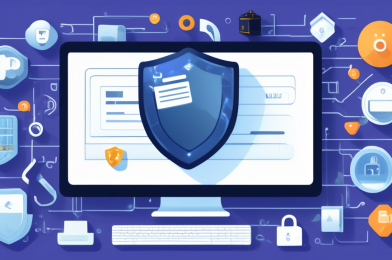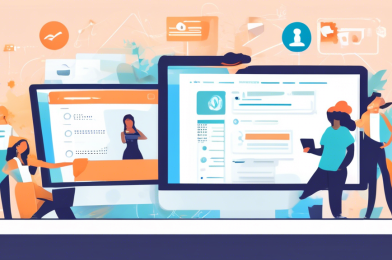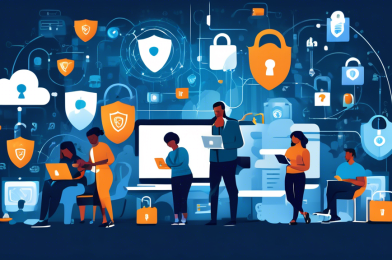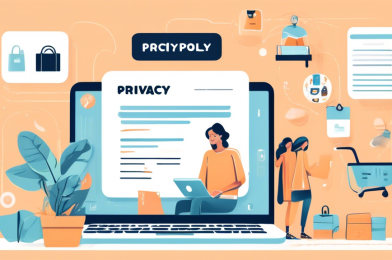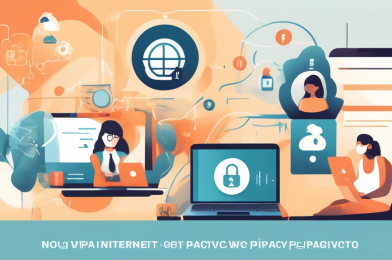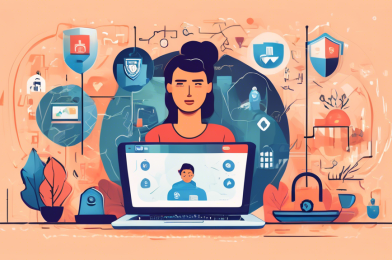Introductory Section
In an era where our digital footprint continues to expand, learning how to protect your data online has never been more critical. Cyber threats are evolving, and with countless personal and professional transactions taking place over the internet, safeguarding your information is paramount. From implementing strong passwords to adopting advanced authentication methods, there are a variety of strategies you can employ to enhance your online security. This comprehensive guide will walk you through top tips to protect your data online, helping you navigate the digital landscape with confidence.
Whether you’re an individual user or managing multiple accounts for a business, investing a little time and effort into improving your cybersecurity can save you from potential disasters. Each section of this article delves into essential practices, from understanding the importance of unique passwords to the necessity of staying vigilant against phishing scams. By the end of this guide, you’ll be equipped with practical knowledge to fortify your online defenses, ensuring your personal and sensitive data remains secure.
Implement Strong Password Practices
Importance of Unique Passwords
In today’s digital age, maintaining the security of your online accounts is more important than ever. One of the primary ways to protect your data online is by using unique passwords for each of your accounts. This practice ensures that if one of your accounts is compromised, the others remain secure. Hackers often exploit the fact that many people reuse passwords across multiple sites, so a breach in one account can lead to a domino effect, compromising your entire digital life.
By creating distinct passwords for each account, you significantly reduce the risk of a widespread breach. Think of each unique password as a lock and key system tailored for individual doors. Even if a hacker manages to unlock one door, they won’t have the key to others, thereby safeguarding your confidential information across different platforms.
Using Password Managers
Remembering a multitude of complex passwords can be daunting, which is where password managers come into play. These tools not only store but also automatically generate secure, random passwords for each of your accounts. This adds an extra bulletproof layer to your efforts to protect your data online.
Password managers encrypt your passwords, acting as a secure vault only accessible by you. Trusted managers like LastPass, Dashlane, and 1Password offer seamless integration across various devices, making it easy for you to manage your passwords without sacrificing security. By using a password manager, you ensure your passwords are not only unique but also robust enough to thwart any brute force attacks.
Regularly Updating Passwords
Even the best passwords aren’t infallible if they remain unchanged for long periods. Regularly updating your passwords is a crucial preventive measure to protect your data online. Frequent password changes minimize the risk of prolonged unauthorized access to your accounts, should your credentials be exposed in a data breach.
It’s recommended to change your most essential passwords—such as those for banking, email, and social media—every three to six months. This routine significantly lowers the window of opportunity for cybercriminals to exploit old passwords. Setting reminders to update your passwords or using features within your password manager to prompt changes can be a helpful practice to maintain this habit consistently.
Utilize Two-Factor Authentication (2FA)
What is Two-Factor Authentication?
Two-Factor Authentication (2FA) is an essential security measure that significantly enhances the protection of your online accounts. It operates by requiring two forms of identification before granting access. Typically, this involves something you know (like a password) and something you have (like a mobile device). By adding this extra layer of security, 2FA makes it considerably harder for attackers to access your accounts, even if they have your password.
When you enable 2FA, you introduce an additional step in your login process, making it more challenging for unauthorized users to breach your accounts. This is a crucial strategy to protect your data online, as it ensures that accessing your accounts requires more than just a stolen password.
Methods of 2FA
There are several methods of Two-Factor Authentication, each offering unique advantages:
SMS Codes
One of the most common 2FA methods involves receiving a one-time code via SMS. Once you enter your password, a code is sent to your registered mobile number, which you then input to complete the login process. Although convenient, be aware that SMS codes can be vulnerable to SIM-swapping attacks.
Authenticator Apps
Authenticator apps like Google Authenticator, Authy, or Microsoft Authenticator provide a more secure alternative to SMS codes. These apps generate time-based codes that you need to enter along with your password. Because these codes are not transmitted over the airwaves, they offer a higher level of security.
Biometric Verification
Biometric verification uses physical characteristics such as fingerprints, facial recognition, or retina scans. This method is incredibly secure, as replicating such unique physical traits is exceedingly difficult. Many modern smartphones and security devices come equipped with biometric sensors.
Hardware Tokens
Hardware tokens are physical devices that generate a temporary code or have a USB key that you insert into your device. These tokens are highly secure and are often used in corporate environments where data security is critical. One popular example is the YubiKey.
Setting Up 2FA for Essential Accounts
Implementing 2FA on your essential accounts is a straightforward process, and here’s how you can do it for major platforms:
- Go to your Google Account.
- Select Security from the navigation pane.
- Under Signing in to Google, select 2-Step Verification and then Get started.
- Follow the on-screen instructions to choose and set up your 2FA method.
- Open your Facebook settings.
- Select Security and Login.
- Scroll down to Use two-factor authentication and click Edit.
- Choose your preferred authentication method and follow the prompts to enable it.
- Go to your Twitter account settings.
- Click on Account and then Security.
- Select Two-factor authentication and follow the on-screen instructions.
Apple
- Open Settings on your iOS device.
- Tap on your name at the top, then choose Password & Security.
- Select Turn On Two-Factor Authentication and follow the setup instructions.
By following these steps and enabling 2FA, you significantly bolster the security of your online accounts, ensuring you do everything in your power to protect your data online. This additional layer of protection can prevent hackers from gaining access to your personal information, even if they manage to steal your password. While 2FA might add a small inconvenience during login, the increased security it provides is well worth the effort.
Stay Vigilant Against Phishing Scams
Recognizing Phishing Attempts
Phishing scams are a prevalent threat when it comes to safeguarding your data online. Recognizing phishing attempts is the first step in protecting yourself. Phishing is a deceptive practice where attackers impersonate legitimate companies or individuals through emails, text messages, or social media to trick you into providing personal information, such as passwords, credit card numbers, or social security details.
Typical signs of a phishing email or message include:
- Urgent or Threatening Language: Phishers often use urgent language, such as Your account will be closed! or Immediate action required!
- Unfamiliar Sender: Emails from unknown sources should always raise a red flag. Even if the email appears to come from a familiar company, double-check the sender’s address.
- Suspicious Links: Phishers often mask malicious URLs with text that looks legitimate. Hover over links to see the actual URL before clicking.
- Attachments: Unsolicited attachments can often harbor malware. If you weren’t expecting a document, don’t open it.
- Personal Information Requests: Legitimate companies rarely ask for sensitive information via email or messages.
Best Practices to Avoid Phishing Attacks
To effectively protect your data online, adopt these best practices against phishing attacks:
- Verify the Sender: Always double-check email addresses and phone numbers to ensure they are from trusted sources. When in doubt, contact the company directly using information from their official website.
- Don’t Click on Suspicious Links: Instead of clicking directly through an email, type the URL manually into your browser, especially for banking or sensitive accounts.
- Look for Poor Grammar and Spelling: Many phishing attempts originate from non-English speaking countries, often containing grammatical errors and misspellings.
- Enable Spam Filters: Most email services offer spam filters that automatically move suspected phishing attempts to a spam or junk folder.
- Use Security Software: Employ antivirus and internet security software that can detect and alert you to phishing attempts and other online threats.
- Stay Informed: Keep abreast of the latest phishing scams by subscribing to security blogs or newsletters.
Responding to a Phishing Attempt
If you suspect you’ve fallen victim to a phishing attempt, quick and decisive action can mitigate potential damage:
- Change Your Passwords: Immediately update passwords for any accounts that might have been compromised. Use unique, strong passwords for each account.
- Enable Two-Factor Authentication: Strengthen your account security by enabling two-factor authentication, making it harder for attackers to gain access.
- Notify Relevant Parties: Contact your bank, credit card company, or any other affected organization to alert them of the situation and take preventive measures.
- Monitor Your Accounts: Regularly check your accounts for unauthorized transactions or changes. Report any suspicious activity immediately.
- Report the Phishing Attempt: Inform your email provider, company IT department, and any relevant authorities like the Anti-Phishing Working Group (APWG) about the phishing attempt.
By staying vigilant against phishing scams and knowing the steps to take in response, you can effectively protect your data online from malicious threats. Recognizing the signs of phishing, implementing best practices to avoid falling victim, and knowing how to respond promptly can significantly reduce your risk of data breaches and protect your personal information.
Conclusion
In today’s digital age, protecting your data online is more critical than ever. Implementing effective security measures such as strong password practices, utilizing two-factor authentication (2FA), and staying vigilant against phishing scams can significantly reduce the risk of data breaches and personal information theft.
Recap of Essential Practices
First and foremost, ensuring that each of your accounts has a unique and robust password is essential. Employing password managers can simplify this task by generating and storing secure passwords automatically. Moreover, regularly updating your passwords keeps your accounts safeguarded against evolving threats.
Enhancing your security setup with two-factor authentication (2FA) provides an extra layer of protection. Whether you choose SMS codes, authenticator apps, or biometric verification, enabling 2FA on your essential accounts adds a significant barrier that potential attackers must overcome.
Finally, maintaining a heightened awareness of phishing scams is crucial. Recognizing the tell-tale signs of phishing attempts and adhering to best practices, such as not clicking on suspicious links and verifying sender information, can prevent you from falling prey to these schemes. In the unfortunate event of a suspected phishing incident, taking swift action by changing passwords and notifying relevant parties is imperative.
By consistently applying these top tips, you can protect your data online and navigate the digital world with increased confidence and security.


